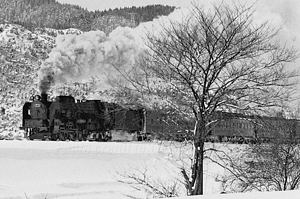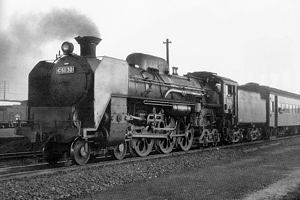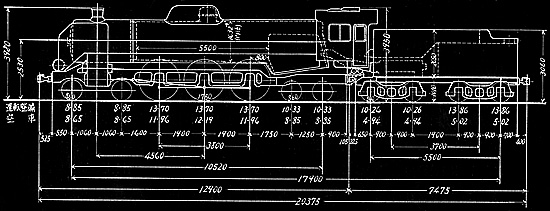
C61 No.19
After a four hour delay in heavy winter snow,
C61_19 with deadhead C61_28 in the rear, steams, the Aomori express.
Japanese
|
1947 - 1974 A large Tender engine for sub-main line passenger trains. |

C61 No.19 After a four hour delay in heavy winter snow, C61_19 with deadhead C61_28 in the rear, steams, the Aomori express. |
|
Mass freight type engines were made during WW2.
Accordingly, after the war, these freight engines became surplus.
On the other hand, passenger engines were not sufficient, but new locomotive products were prohibited by the American occupation forces.
An attempt was made to find a solution to this impasse,
that from these surplus freight engines it may be possible to construct a passenger model.
C61 appeared in such a background.
The C61 was reconstructed from the freight model D51. The upperbody boiler and some parts were diverted from the D51. But the underbody was almost newly produced from the basic C57 design, and the axle was arranged to 4-6-4. For practical purposes, the C61 was almost the same as a new model. Therefore, compared to new engine manufacturing, C61's reconstruction costs were 80% of a new engine. C61's name was actually a precursor to the later appearing class C60. Therefore there was no conflict in the name of D51's "1" and C61's "1". The first C61 was remodeled from the D51_615 at the Mitsubishi Jyuko Co. it's manufactured number was 640 during November 1947. She was active on the Tohoku line, Sendai depot until August 1968. And was preserved at the Tohoku Railway School in Sendai. But unfortunately, it was later scrapped in 1995. A total of 33 were reconstructed during the 1947-1949 period. The total of 33 engines was fewer than originally planned. According to the original plan, a total of 40 each was contemplated of the C61 and C62. However, 49 C62's were made and as a result the total number of C61's was reduced so the total number of around 80 was achieved. C61 went into service on the Utsunomiya, Sendai, Morioka and Aomori depots, operating for the Tohoku line. And also saw service on the Jyoban line Oku depot, Tosu depot for the Kagoshima line. The C61's culling began during 1965, from Tohoku and Jyoban lines electrification. But most of the C61s were turned over to the Ou, Nagasaki, Nippo lines. During 1965 deployment was as follows : 8 in the Aomori depot (No.1, 7, 16, 17, 18, 22, 23 and 30) for the Tohoku line and Ou line between Akita and Aomori. 19 in the Sendai depot (No.2-6, 8-11, 15, 19, 20, 21, 24-29) for the Tohoku and Jyoban line, 6 in the Kagosima depot (No.12, 13, 14, 31, 32 and 33) for the Kagoshima line. ... total 33. C61's final service was on the Nippo line, Miyazaki depot. Their were six C61's (No.2, 18-20, 24, 28), and were retired during 1973. |
| Primary ran line in last 10 years |
Kagoshima, Nippou, Tohoku, Ou
| Last line/depot and year |
Nippo line / Miyazaki depot 1973
| Restored engine (2017) |
2 (No.2, 20)
| Preserved engine (2017) |
2 (No.18, 19)
| |

|

| ||||
| We see C61_24 last winter runnings on the Ou line. Tugaru-Yunosawa, Feb 1970. |
Class C61 their last active on the Nippo line. C61_18 Miyazaki depot, Mar 1974. (Photo credit to Nicholas Pertwee)
| 
| 
C61_30 at Hanamaki station, Tohoku line | Jul 1959. (Photo credit to S.Sumino)
C61_13 pulling a Limited express "Hayabusa (Falcon)" | at Hakata on the Kagoshima line during Apr 1959. (Photo credit to S.Sumino) |

| Configuration | 4-6-4 | Dimensions Length (mm) | 20375 |
| Engine Weight (Operating tons) | 79.5 | Driver size (mm diameter) | 1750 |
| Boiler pressure (Kg/cm2) | 15.0 | Max Tractive effort (tons) | 10.3 |
| Driver Max Power (PS) | 1390 | Max Speed (km/h) | 100 |
| Manufactured years | 1947-1949 | Total production | 33 |
| Gauge | 3ft 6in (1067mm) |
Introduction |
Go to Top |